For decades, Airstream has been the shining example of how to design a camper that’s both timeless and built well. It’s why the brand of “silver bullet” trailers is one of the most iconic camper companies on the planet. In 2011, big RV brand Keystone launched a camper that looked suspiciously like an Airstream. The Keystone Vantage wasn’t an Airstream, and instead, it was a weird, giant fiberglass camper that never got its chance to shine.
History is full of camper designs and companies that have existed for only a short time before disappearing. Some campers have sold for a year or two before vanishing, and some evaporated almost without a trace. Honestly, this has happened so many times throughout RV history that I cannot even begin to estimate how many brands and models have failed to catch on. Who knows how many brands have died without even a piece of paper out there explaining that the company existed in the first place?
The Keystone Vantage is one of those trailers. It sold for only two years, and it’s not something that Keystone itself mentions anywhere on its website. The trailer’s so rare that there’s a good chance you’ve never seen one, and perhaps never will. That’s why I was shocked to find one of these on Facebook Marketplace in decent condition. But what’s perhaps wilder about the Vantage is that you don’t even need to squint to realize that it’s like an alternate reality Airstream.
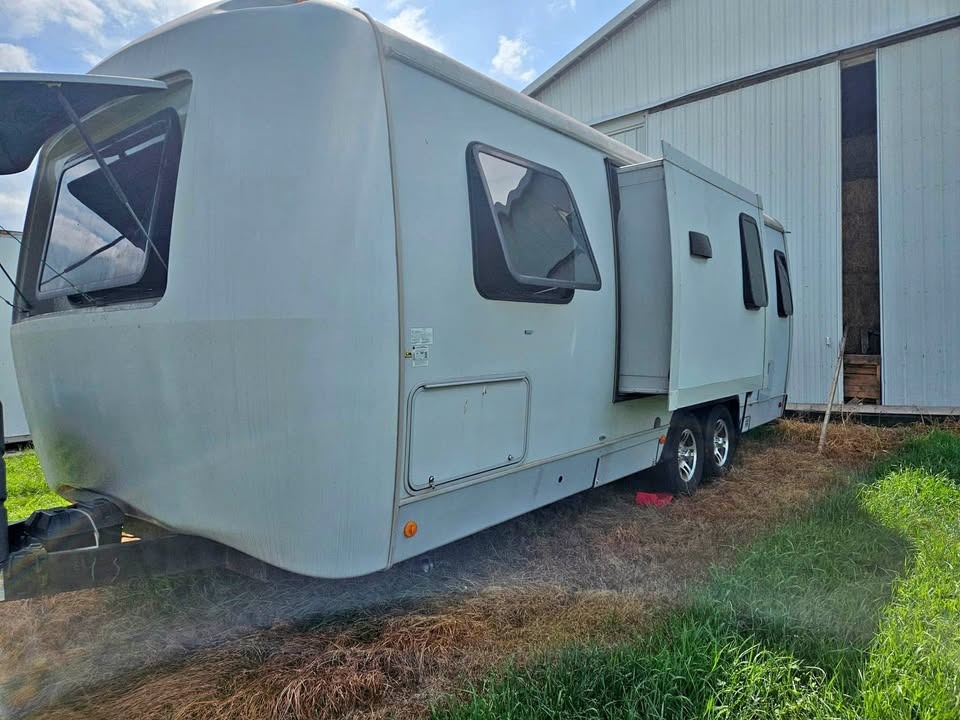
Keystone
Keystone was founded in 1996 by Cole Davis with the mission of building feature-packed RVs for thousands less than the competition. This might seem like too simple of a concept, but it worked. By 2000, Inc. 500 said that Keystone RV was the second-fastest-growing company in America. Thor Industries liked the sound of that and purchased the brand in 2001.
Today, Keystone is one of the brands in Thor’s portfolio with some great ideas. I recently wrote about trailers like the Keystone Reign, the Keystone Sprout, and the Keystone Walkabout, a trio of campers that don’t use an ounce of wood in their construction and do away with boring swoop decals for attractive automotive-style finishes.
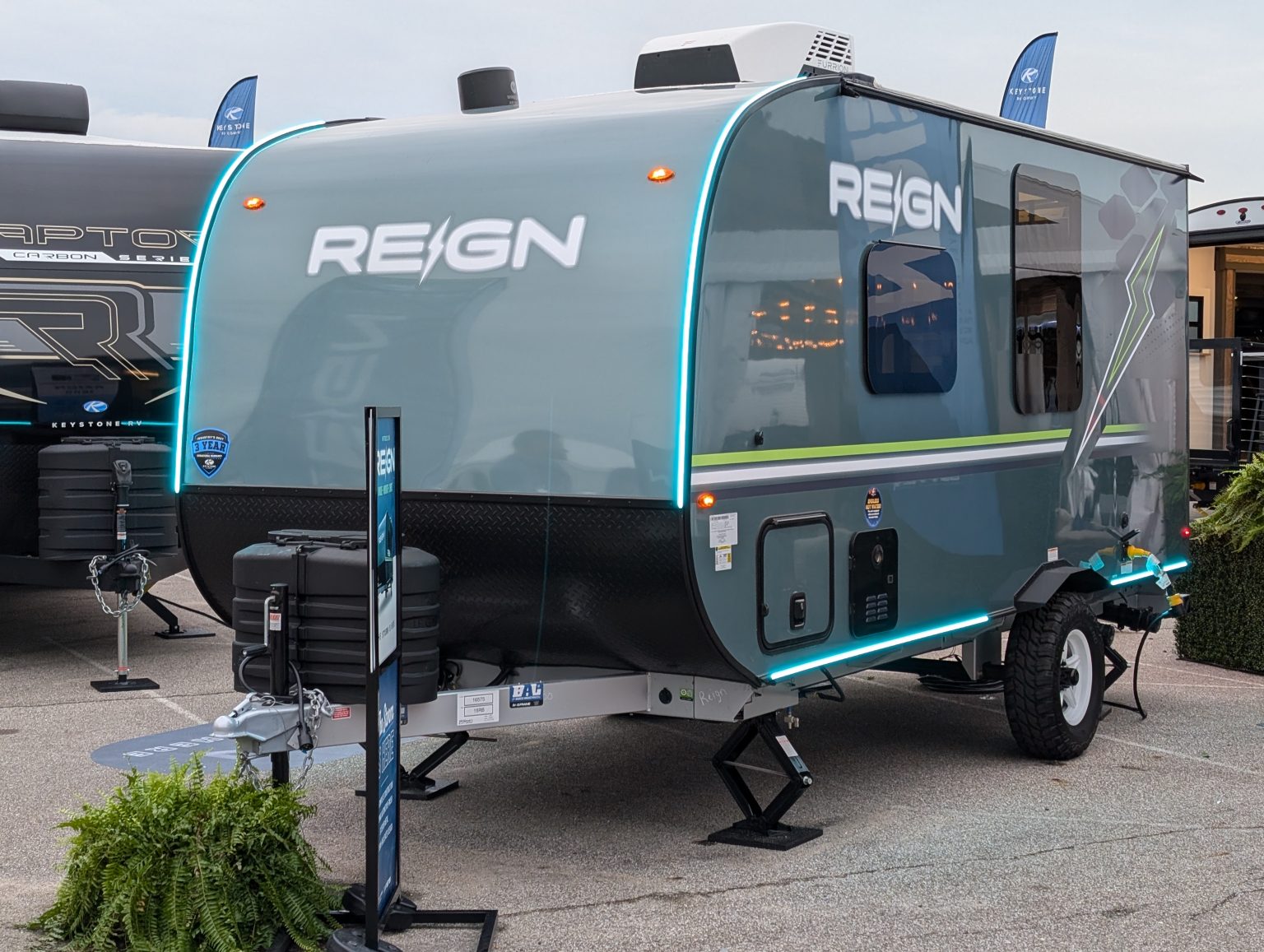
Meanwhile, Airstream isn’t just a Thor brand; it was the very first brand scooped up by Thor Industries and serves as Thor’s flagship brand. It’s unclear if Keystone intentionally made a camper that looked like an Airstream, but it doesn’t really matter. As soon as the Vantage hit the market, people immediately started comparing it to Airstream.
I could not find any details about what inspired Keystone to build the Vantage, but I can tell you that it went into production in 2011.
Vantage Point
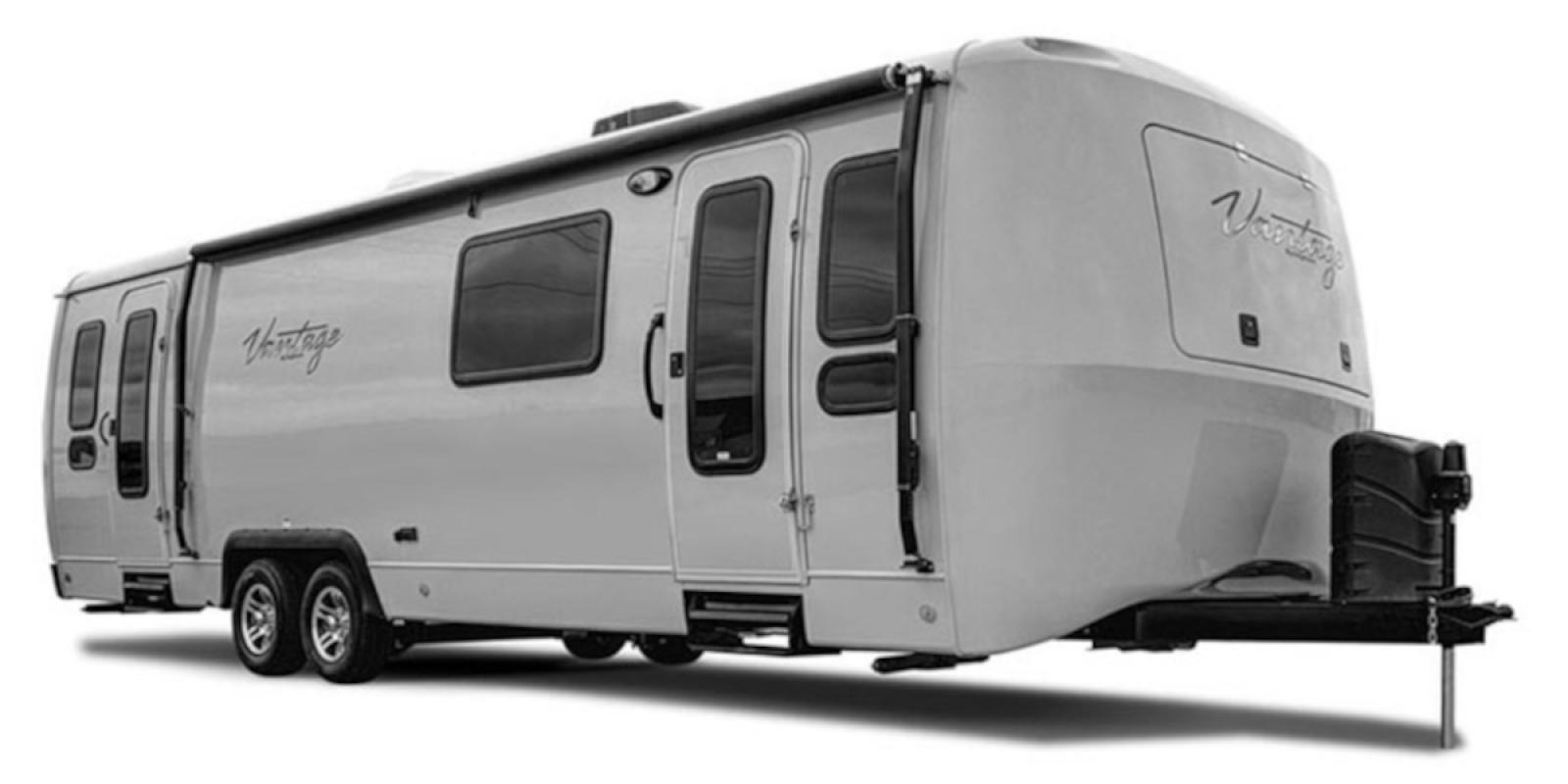
The Vantage is built on a Norco steel frame with a six-sided aluminum skeleton on top. From there, Keystone draped the trailer in curved vacuum-bonded laminated fiberglass walls and capped off in front and back with one-piece fiberglass caps. The company bragged that the Vantage is a true widebody that stretches out 101 inches wide. Apparently, the curved walls, which add six inches of width, allow the camper to hit the 101-inch width. Even the roof is curved, which allows for six feet, 10 inches of headroom at the peak of the trailer and six feet, six inches at the sides.
There is a weird part about the body, and it’s that Keystone went through all of this work to make a weird curved aluminum and fiberglass body, but did nothing special with the roof. The roof has plywood decking and a rubberized coating. Some Vantage owners reported having roof seam defects on new trailers. Honestly, I think Keystone could have avoided that by using fiberglass on the roof, too.
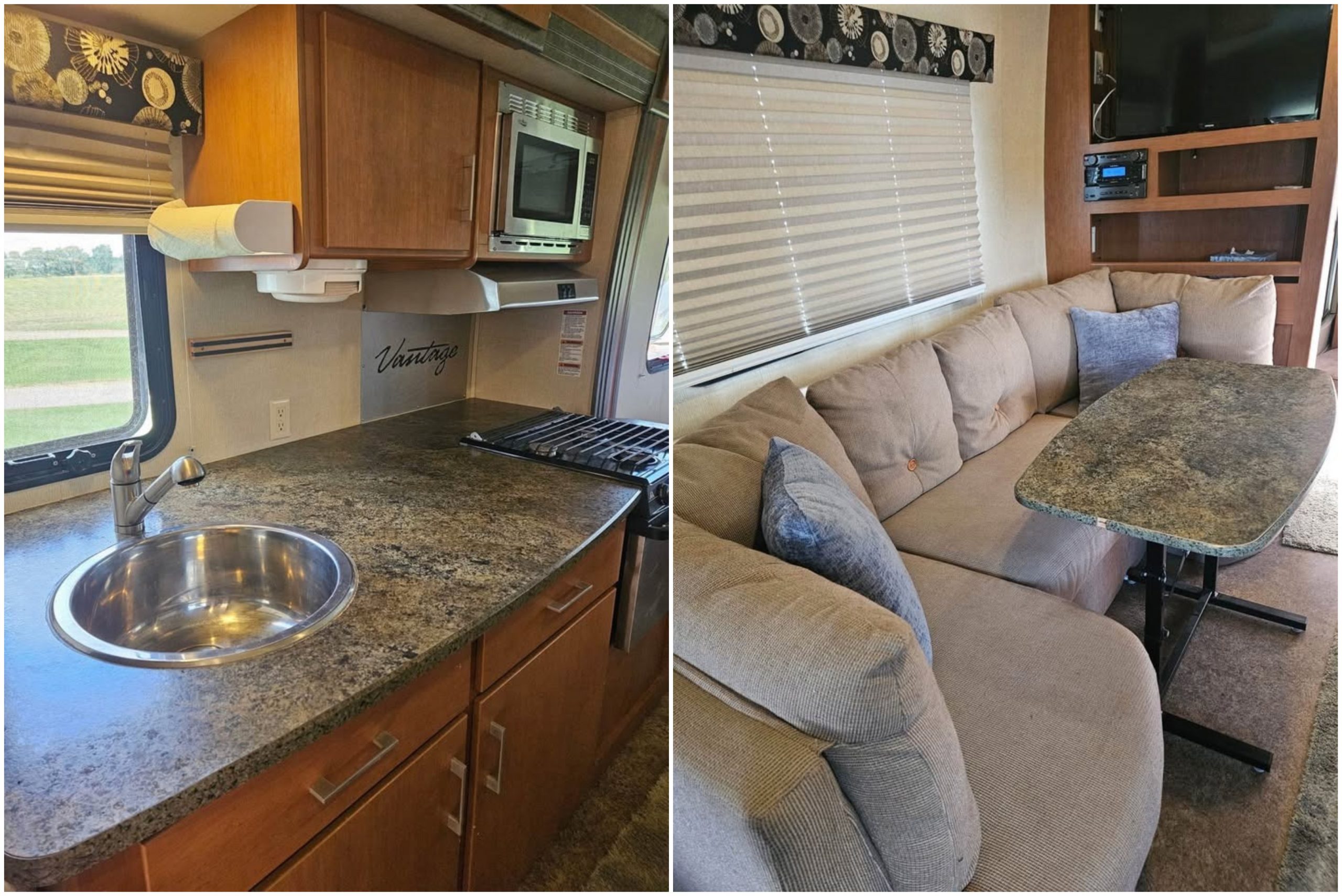
What triggered the comparisons to Airstream is what happened next. Every Vantage was painted in a glossy gray that looks like dull aluminum. The trailers were also given a fiberglass front window cover, and the side windows were of the distinctive double-stack variety that you get in an Airstream. The body design was finished off with an ABS plastic bumper and LED lighting.
Trailer Life Magazine went as far as to say that the Vantage didn’t just look like a clone of an Airstream, but also a clone of the GMC MotorHome. To be fair to Keystone, it never directly called out any RV as inspiration, and instead just said that the Vantage had a “classic, timeless shape.”
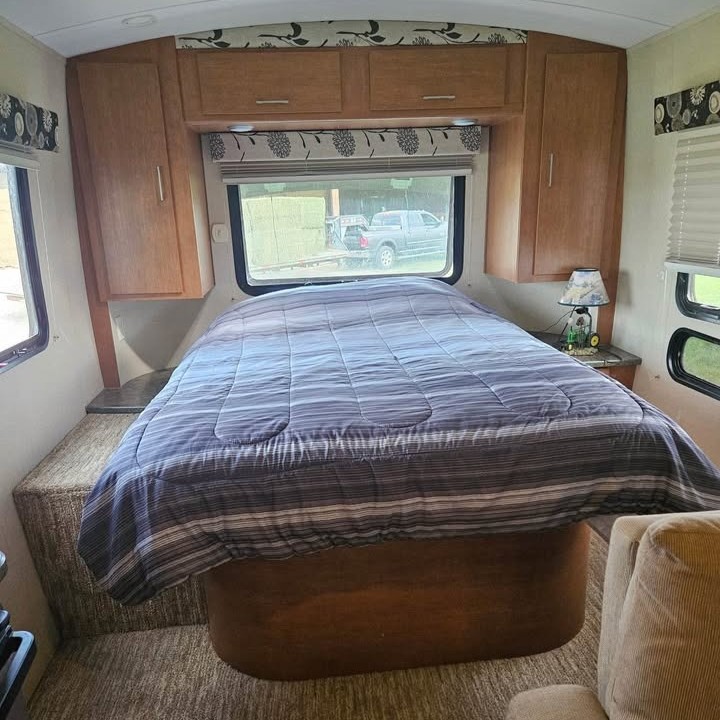
Inside, Keystone didn’t really help itself ease the comparisons to Airstream as the Vantage went for a luxury open floorplan, not unlike an Airstream. Four models were advertised, ranging from the 23’7″ 19UL to the 35′ 10″ 32FLS. All versions of the Vantage but the 19UL put its kitchen and some seating on a single slide.
Features included an entertainment system with a radio, a DVD player, and an MP3 player AUX jack, a six-cubic-foot fridge, a three-burner stove, a 10-gallon water heater, an air-conditioner, and a 30,000 BTU furnace. Other niceties noted by the brochure are a porcelain toilet, ball bearing drawer guides, stainless steel appliances, an aluminum base floor, an air mattress, a 32-inch HDTV, and a low suspension. The only options were a ducted air-conditioner and Canadian certification documents. Technically, the TV, alloy wheels, the water heater, and the air mattress are also options, but they’re in mandatory options packages, so they don’t really count.
In other words, the Vantage came fully loaded right from the factory, much like an Airstream. No matter which version you bought, you also got 50 gallons for fresh water, 30 gallons for gray water (exception being the 25RBS, which had a 60-gallon gray tank), and 30 gallons for waste.
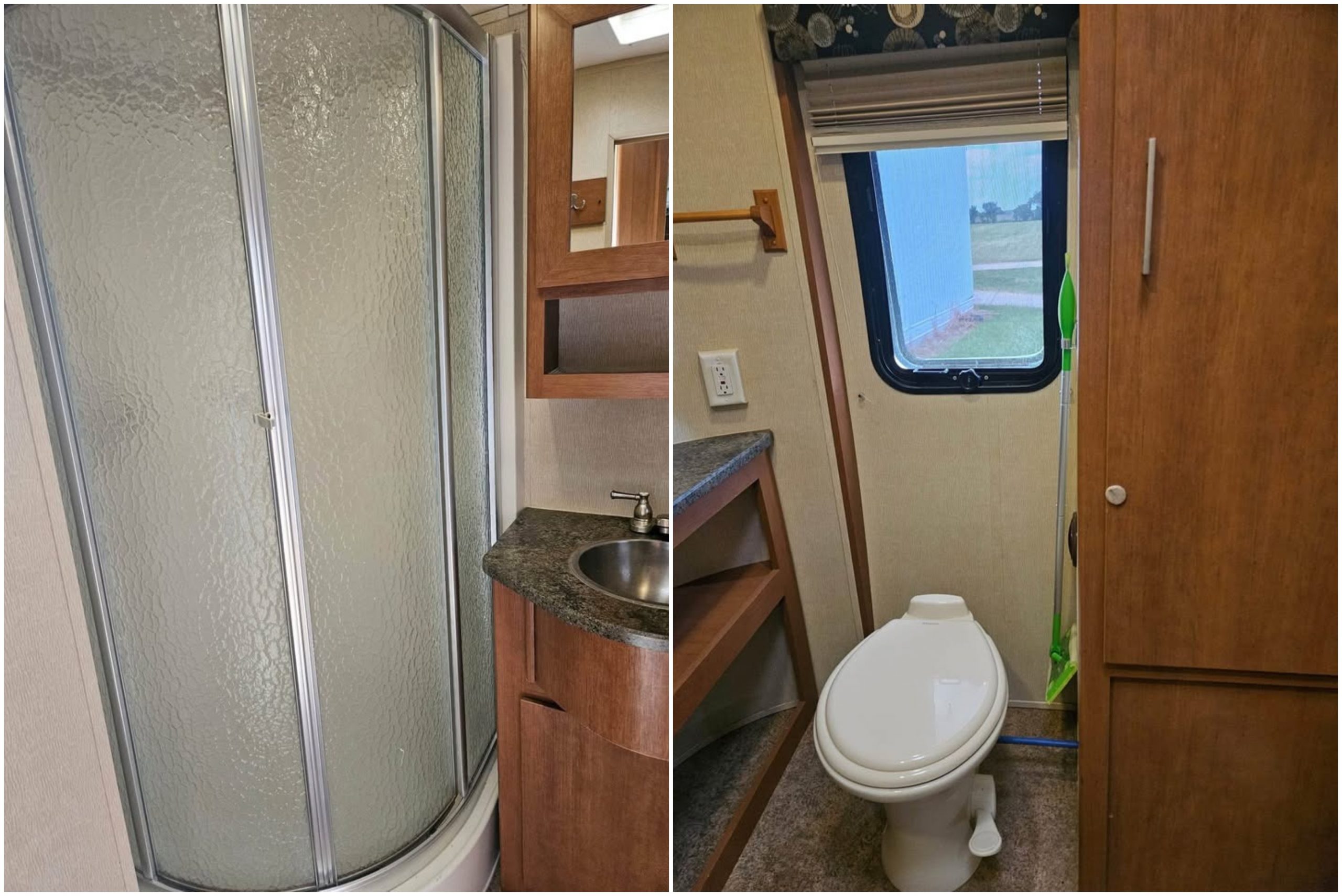
The trailers launched in 2011. Sadly, I could not find concrete pricing for all four models, but I can tell you that the biggest 32FLS trim had a base price of $37,205.
What’s weird is that these trailers were not on sale for long. Production lasted through much of 2012, and Keystone even produced many 2013 models, but then it all fell apart. Keystone deleted the Vantage’s website and other information online in November 2012, suggesting that production didn’t even reach 2013. It’s unclear why Keystone scrubbed the Vantage from existence so soon. But the fact that these appear to be rare might suggest that not many were sold.
That brings us to the Vantage that I found for sale in Indiana, as featured in this piece.
This Vantage 25RBS
I didn’t really know what to make of this camper until I found out how it was built. Indeed, at first it looked like a bizarro world Airstream to me. But the lack of fiberglass and all of the seams screamed that this wasn’t exactly the same thing. The seller says that this camper is “molded fiberglass,” but that’s incorrect. It’s fiberglass draped over a metal skeleton with a rubberized roof.
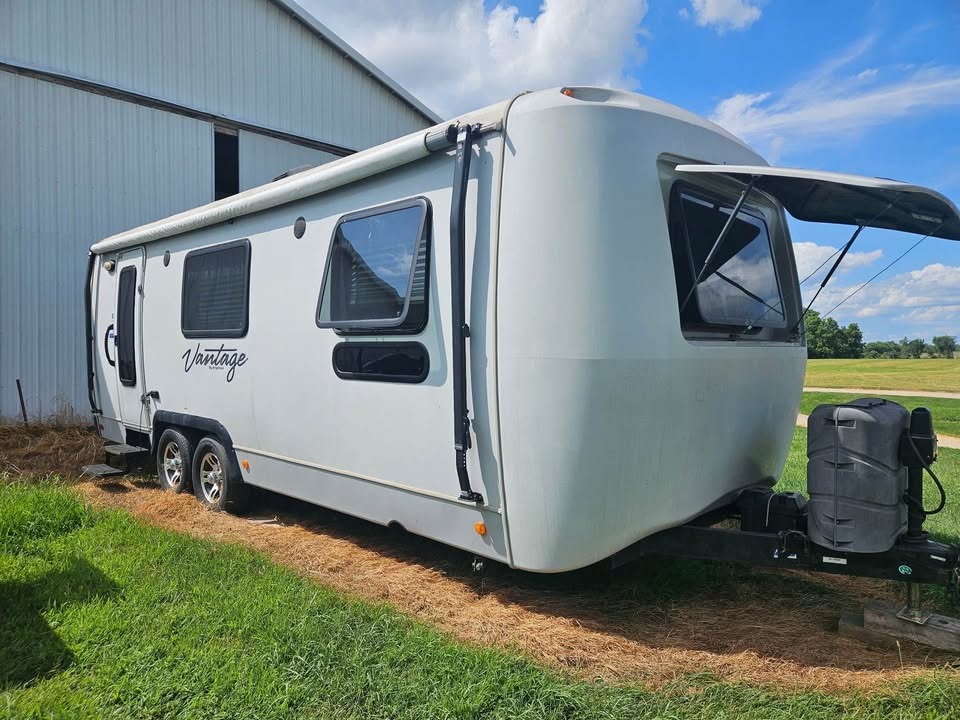
This model is the middle child of the lineup, the 25RBS. In a weird way, the 25RBS is sort of like Airstream’s popular 25RB floorplan, but reversed. The door is in the back and the bedroom is in the front, the opposite of an Airstream. This trailer has a 25-foot body, but measures 29 feet overall.
In this layout, there’s a bathroom in the rear, a kitchen and dinette in the rear, and the aforementioned bedroom up front. All of the features I talked about before are here, and, at least in the low-resolution Facebook pictures, the trailer looks nice inside! That bed up front is an RV queen unit, and the dinette turns into another bed.
Two things that I appreciate about this trailer’s design is its shower, which appears bigger than average for this size class, and the fact that the stove at least has something resembling a backsplash, though its coverage isn’t the greatest.
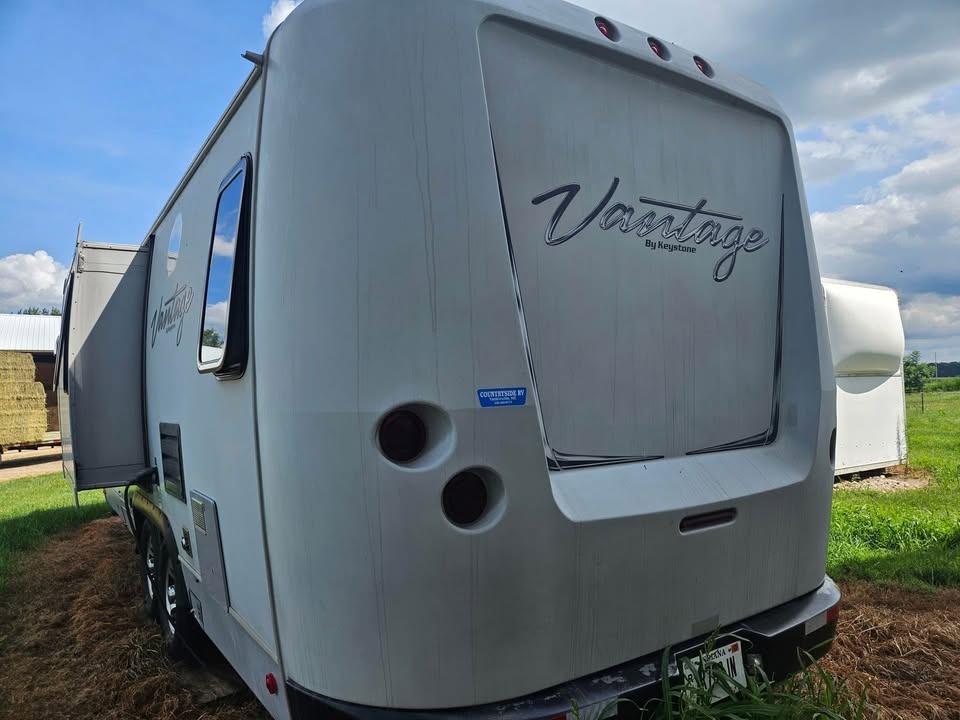
According to Keystone, this trailer should weigh 5,855 pounds when empty and a fat 8,200 pounds when loaded. Yep, this may have loads of fiberglass on it, but you aren’t going to tow it with your Volkswagen Atlas. Shoot, not even my Volkswagen Touareg V10 TDI is rated to tow this thing.
The seller, who is based in Indiana, wants $14,000 for this trailer, which seems reasonable, and I bet you could negotiate them down. But I’m not sure I’m sold on its concept. The use of fiberglass and metal framing is excellent. But then, Keystone went ahead and gave it a plywood and rubber roof, anyway, which means that the roof is just begging to leak one day. At the very least, the metal and fiberglass walls mean that the rot won’t be so bad, but in my eyes, the roof seems sort of half-baked.
Still, if you’re looking for something that’s at least a step up from a stick build, it sounds like the Vantage could be an interesting pick. At the very least, it looks much different from the typical camper! This trailer also makes me think, how many weird and cool trailers have we lost to time?
Top graphic image: Facebook listing

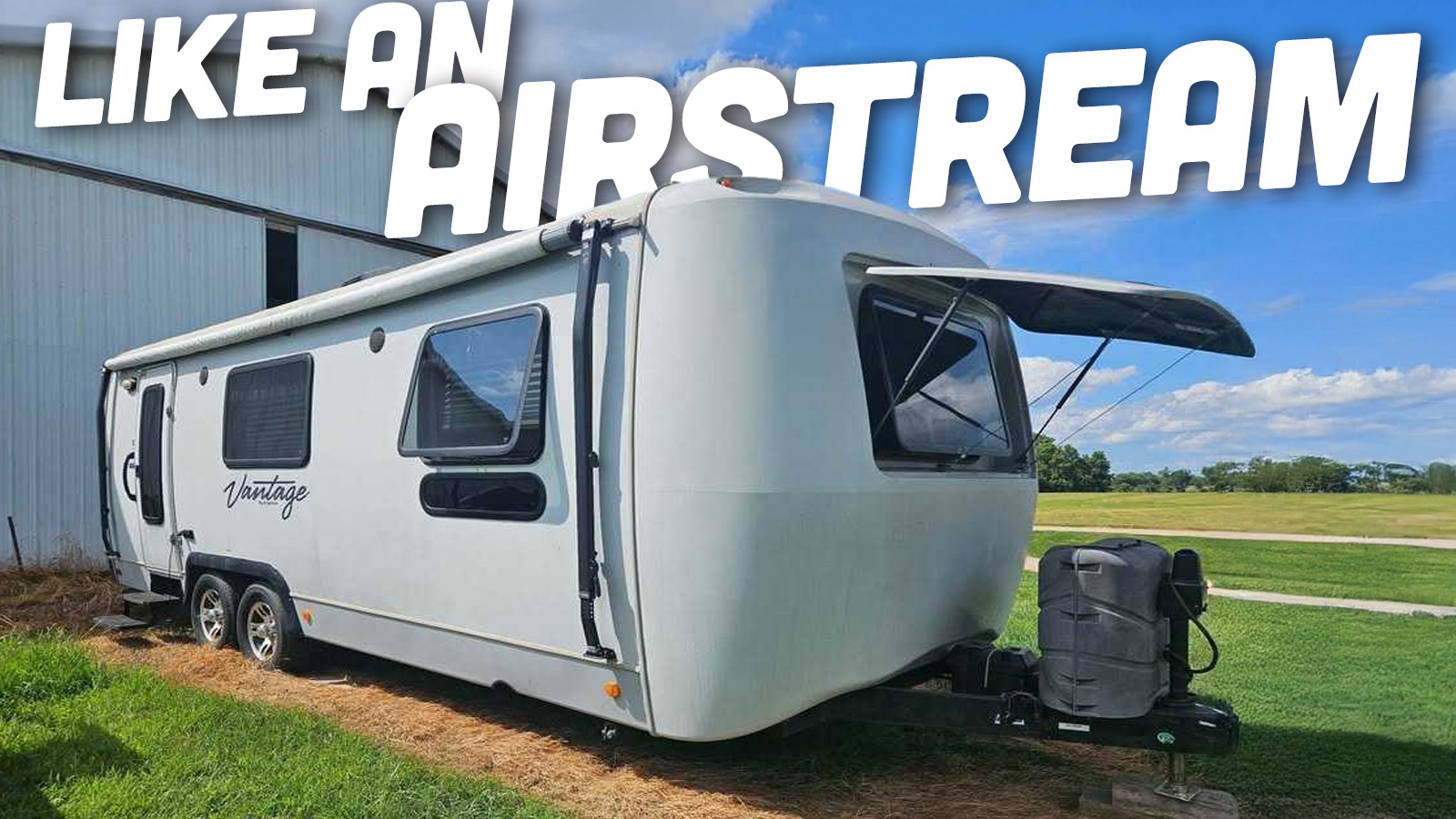




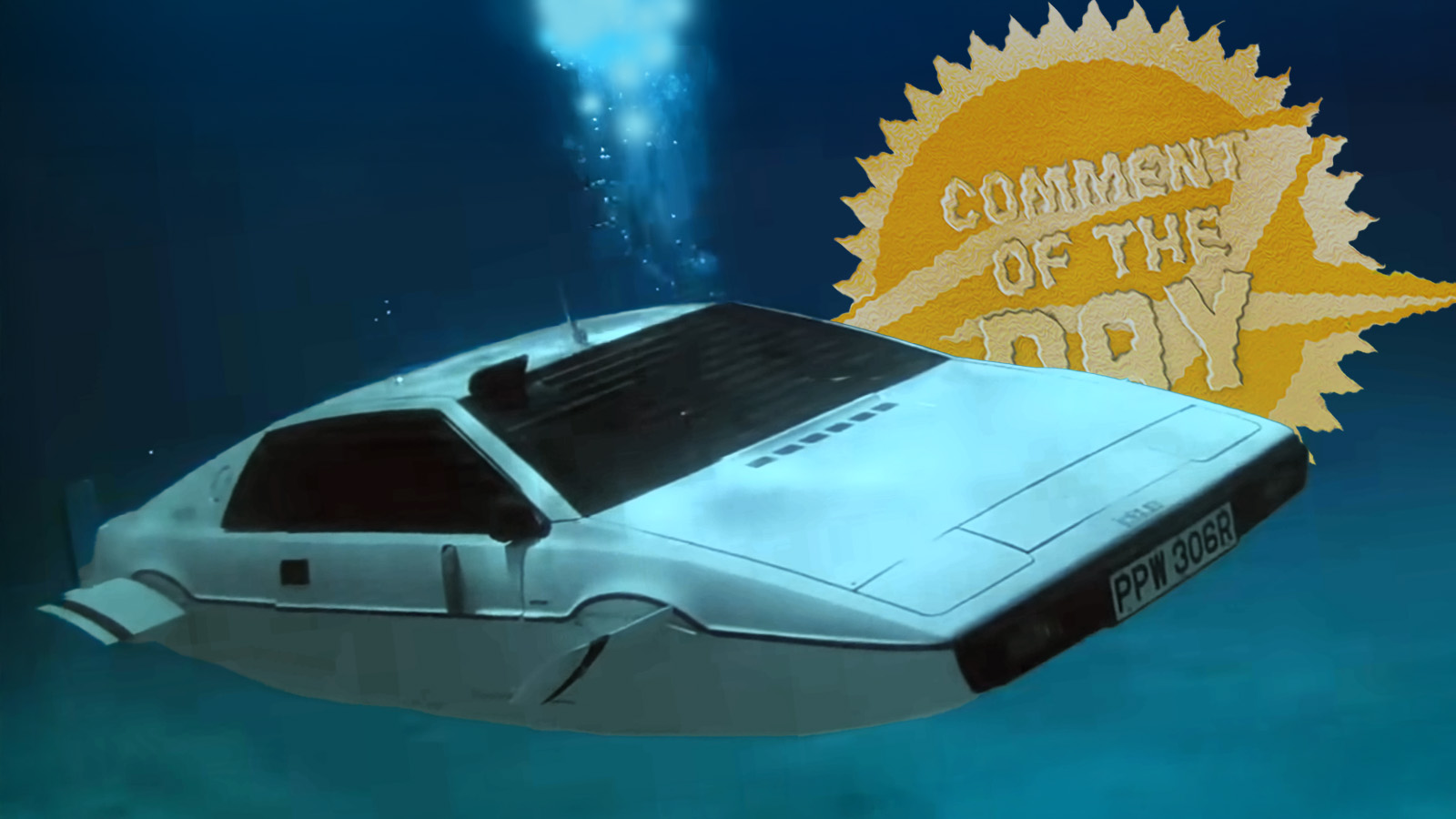


The roof is a deal breaker, and may have been a sales killer. The whole point of fiberglass trailers like Boler or Bigfoot is the one piece roof. This thing will leak just like that super cheap Coleman and it seems very heavy. 8200lbs exceeds the capacity of my old F150. This is interesting but definitely a swing and a miss
Current 25/27 foot Airstreams are all front bedrooms with rear dinettes. For a few years they did offer the same floor plan in either rear or front bed, but now that size is all front bed.
Vantage really dropped the ball with the roof… I feel like they were making them to a price point and then ran out of money when they got to the roof.
The choice of roofing materials for this RV was indeed an odd choice. I agree with Trailer Life, this gives off some strong GMC Motor Home vibes.
Having now read quite a few of these posts, can you explain why RV manufacturers justify such terrible designs for water ingress & medium-term failure of roof seems rather than just having a 1pc fibreglass cap?
The industry seems bent on racing to the bottom with poor quality, poor work conditions, and poor worker rights (I know Indiana is on purpose), – with any new entrant either getting undercut on price (because making good stuff costs money), or bought up.
Probably because its cheaper and customers don’t seem to care, because they keep buying anyway
As Ranwhenparked said, it’s all about cost. And most RV owners don’t keep them very long, so it usually works out to be someone else’s problem.
Self-fulfilling.
Don’t keep them long because they’re built like crap.
Thus keep buying new ones to replace the previous crap.
And they continue to build like crap so you have to buy another one.
Yet people continue to buy, knowing they’re crap.
Until, it seems, you come across an Airstream.
Proving it doesn’t have to be that way.
I really don’t care at all about RVs or campers, yet I find myself reading these posts.
Mercedes, you could do a series on garden wheelbarrows and we’d probably read it religiously.
One wheel or two?
Motorized wheelbarrows ICE or EV?
EV. I don’t need to smell like exhaust after a day of work.
PS. Since you are in MKE, don’t forget to chss as new out the wheelbarrow tire to a winter tire soon.
I’m thinking about using chains this year, although my barrow is so rusted out it’s really 2 sticks and a flat tire.
Makita makes one that runs on 18V drill batteries, along with a coffee maker and a microwave.
I don’t know. Are those different DOT categories? I thought they were just rated according to how much shrimp they can hold.
This is why we need a series. Inquiring minds want to know.
Can a single wheel barrow be motorized using a 90+ mph unicycle?
Only Miss Mercedes can answer these questions!
The rear cap looks like it came off of a van-based airport shuttle bus. And if that’s so, then it makes me wonder if the sides and their construction are also based off of fiberglass bus body construction; in that case Keystone would have just modified some existing jigs and added their own templates for cutting window openings etc.
Makes me wonder that if you found whoever built a van-based shuttle using that endcap, you might find that they may have had their production line idled for a couple of years, or were going through a sale/acquisition and they leased out some tooling or production capacity to Keystone for a while to keep some cashflow going.
Also, while the inside looks Airstream-ish, the interior, at least to me, looks like modified generic RV plywood-and-laminate stuff. Airstream interiors tend to be a good deal more unique and purpose-built for the Airstream shell.
I thought this was great until the roof- I only purchase RVs with fibreglas roofs